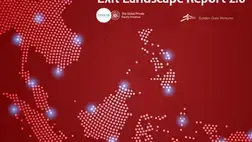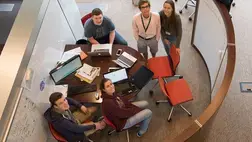Welcome to GPEI
In the Spotlight

GPEI Report

INSEAD Knowledge Article

INSEAD Publishing Case

INSEAD Research Publication
Resources

The Politics of Mutual Fund Managers’ Voting

When Shareholders Share, the Business Benefits

Thinkers50: The Road Ahead for Venture Capital

Venture Capital Crucial to Push for ‘Ethical’ AI and Tech Standards

Can Private Equity Make Money While Doing Good?
Click here for more INSEAD Knowledge articles on private equity

Southeast Asia Exit Landscape Report 2.0

GREEN SHOOTS: Can Private Equity Firms Meet the Responsible Investing Expectations of Their Investors?

The Institutionalization of Family Firms - Europe

Responsible AI and Tech in Start-Ups

LP strategies for a post-COVID climate: PE and VC allocations

Private Equity’s COVID Recovery Plan

The Private Capital Advantage

The Pervasive, Head-Scratching, Risk-Exploding Problem With Venture Capital

Click here for the full list of student projects

Impact Investing Private Equity Market Mapping

Krakakoa – Exit Strategy

Corporate Venture Capital

KK Fund – Growth Strategy for VCs

The Future of Boards and The Board of the Future

The Defensible Startup

Corporate Innovation through Venture Building

Investing at the Crossroads of Biotech & Food

LEGO Ventures Analysis Proposal Investment Decision in Digital Play in Asia

Southeast Asia VC HealthTech Landscape
Partners
It is GPEI's role to further INSEAD's ability to produce the unbiased, data-driven output and insights needed to fuel success in private equity and to provide a trusted forum for the exchange of ideas and learning within the industry. As a non-profit organisation we depend on support from individual and corporate partners.
Corporate Partners
We thank our Corporate Partners for their multi-year commitment to GPEI and their longstanding support. It is not only a strong endorsement of our efforts, but allows us to extend the boundaries of private equity research and create a consistent dialogue between PE research and practitioners.
-
Alumni Partners
-
Many of INSEAD's alumni are either working in the private equity industry or have benefited from it as entrepreneurs and managers. Please consider supporting a specific research project or the overall development of PE at INSEAD. We are grateful to acknowledge support from the following alumni supporters:
Christoph Rubeli INSEAD MBA '92D Christian Stahl INSEAD MBA '98D Gilles Destremau INSEAD MBA '87J Mark Ellison INSEAD MBA '83J The Frank and Mary Dubczak Fund Zhou Chuangen INSEAD MBA '00D Several anonymous donors Advisory Board
Some alumni who hold senior positions in the PE industry support and advise GPEI on an ongoing basis through our alumni advisory board. All members commit to the advisory board for several years to have a measurable impact on the centre's strategy and execution.
We are looking for individuals who are passionate about the industry and INSEAD to help us define our role in the ecosystem. The following alumni constitute the advisory board. We are grateful for their support.
-
Research and Project Partners
-
Research Partners
Our Research Partners support GPEI with access to their data and cooperate with us on individual research projects:
Specific Project Partners
We partner with companies on specific projects. In addition to sponsorship, we are looking for access to data allowing us to develop original research. A selection of our project partners is shown below:
-
Becoming a Partner with GPEI
-
INSEAD GPEI attracts funding from top international companies; our founding core supporters include General Atlantic, Boston Consulting Group and PricewaterhouseCoopers. Read Press Release.
It is GPEI's role to further INSEAD's ability to produce the unbiased, data-driven output and insights needed to fuel success in private equity and to provide a trusted forum for the exchange of ideas and learning within the industry. As a non-profit organisation we depend on support from individual and corporate partners.
Partnership Options
Option 1: Alumni Partners – for INSEAD alumni in the PE industry
GPEI is supported and advised by a board of alumni in senior positions in the PE industry. These selected INSEAD alumni provide strategic guidance for the centre as well as resources needed for the centre to execute its vision. If you do not have the time to commit to our board, please consider supporting us on individual projects or with a donation to benefit the overall development of the centre via:Option 2: Corporate Partners – for companies in the PE industry
Join GPEI's consortium of leading industry partners – a select group of partners with complementary backgrounds. This group of corporate partners, together with the alumni board, constitute GPEI's advisory board. The size of the group will be capped and in order to join we ask for a multi-year commitment.Option 3: Research or Project Partners
If you are interested in being associated with specific areas of research or want to further knowledge development and its dissemination in the industry, please contact us for a discussion. To be clear, we do not engage in customised publications for paying clients ('research for hire').Partnership Benefits
GPEI's partners enjoy the privilege of being associated with a vibrant and open research environment. Through their association with GPEI, our partners receive significant recognition and visibility through their involvement in high-profile events, publications and the distribution of our reports across global networks.
Send us a message
Contact us if you have any questions or if you would like to make a referral to potential partners.
Research Initiatives
Offer your insights: Survey for Corporate Venture Capital and Startups

The team at GPEI are currently undertaking research to understand the nature of collaboration between corporations and startups, more specifically with the Corporate Venture Capital (CVC) arm of large multinationals and their ability to attract startups into their portfolio.
We are currently looking for both CVCs and startups to offer their insight...
Read MoreResponsible Investing

Investors and companies have expressed a growing appreciation of the impact that nonfinancial factors can have on value creation, long-term company performance, and the health of society at large. Over the past half-decade, this rising level of awareness has been spurred on by several organisations and industry bodies – such as the United Nations...
Read More-
Click here to view output
-
Research
- GREEN SHOOTS: Can Private Equity Firms Meet the Responsible Investing Expectations of Their Investors?
By Sara Lim, Ian Potter and Bartek Walentynski
October 2020 - ESG in Private Equity: A Fast-Evolving Standard
By Bowen White, Claudia Zeisberger and Michael Prahl
May 2014
News
- COVID-19 Accelerates ESG Trends, Global Investors Confirm
Fiona Reynolds
UNPRI
September 2020 - Investors Integrating ESG Can Indeed Do Well by Doing Good
By Charlie McGrath
Preqin
September 2020 - ESG Goes Mainstream in Private Capital
Preqin
September 2020 - Study Rebuts 'Widespread Claims' of ESG Outperformance amid Covid Turmoil
By Alf Wilkinson
Ignites Europe
August 2020 - ESG ETF Assets Break $100bn Barrier
By Alf Wilkinson
Ignites Europe
August 2020 - Impact Investing in Covid-19 Times: A Three-Step Mission
By Alexandra von Stauffenberg
INSEAD Knowledge
June 2020 - Mainstreaming Impact Investing: What Do Investors Want?
By Kevin Lu, Shunsuke Tanahashi, Noelle Tan
The Business Times
June 2018 - Impact Investing Comes Into Its Own
By Claudia Zeisberger and Kevin Lu
INSEAD Knowledge
April 2018 - Building an Impact Investing Business that Makes a Real Difference
By Jasjit Singh
INSEAD Knowledge
March 2018 - The Stars Are Aligning for Socially Responsible Investing
By Ian Potter
INSEAD Knowledge
March 2017 - Getting the Big Money into Social Impact
By Ian Potter
INSEAD Knowledge
August 2015 - Corporate Sustainability is More Than Just Ticking the Regulatory Box
By Jasjit Singh
South China Morning Post
September 2015 - What are the Prospects for Impact Investing?
By Hugo Greenhalgh
Financial Times
December 2015 - With Pressure from Investors: Private Equity Considers ESG
By Katie Gilbert
Institutional Investor
November 2014
Resources
Case Studies
- Private Equity Real Estate Investors – Overcoming the Challenge of Sustainability & ESG: Pro-invest Group’s ESG Journey
Claudia Zeisberger, Alexandra von Stauffenberg, Cindy Van Der Wal
April 2022 - Credit Suisse: Building an Impact Investing Business in Asia
By Jasjit Singh and Joost Bilkes
August 2017
Events

We congratulate this team of INSEAD MBA'17D students for winning this year's MBA Impact Investing Network & Training (MIINT) competition! Advised by Ian Potter, the team pitched an online medical venture to win the competition, which included six months of preparation and an intense two-day competition involving 125 students from 25 business schools around the world.
- GREEN SHOOTS: Can Private Equity Firms Meet the Responsible Investing Expectations of Their Investors?
Corporate Venture Capital

Corporations are in a race to stay ahead and relevant as new technologies and business models upend their businesses. While internal R&D is still the main source of innovation, Global 2000 companies have turned increasingly to strategic acquisitions and venture capital investments to drive top-line growth, accelerate time to market and exploit...
Read More-
Click here to view output
-
Research
- Corporate VC Is Booming, but Is It What Your Start-Up Needs?
By Nicolas Sauvage, Claudia Zeisberger and Monisha Varadan
August 2022 - Is Corporate Venture Capital Right for Your Startup?
By Nicolas Sauvage, Claudia Zeisberger and Monisha Varadan
July, 2022 - Corporate Venture Capital
By Laura Rivera, Abhinandan Jain, Guillaume Iserin, Sangwoo Pak, Ingrid Vallee, Jermayne Chan (Class of MBA'21J)
April 2021
Case Study
- Corporate Venture Capital Primer
By Peter Ziebelman, Claudia Fan Munce and Matthew Saucedo
December 2017
Resources
- How Covid-19 Is Impacting Corporate Venture Capital Investment
CB Insights
June 2020 - The 2019 Global CVC Report
CB Insights
March 2020 - Unlocking Corporate Venture Capital
500 SU
October 2019 - The Golden Mean of Corporate Venture Capital
Pitchbook
May 2019 - The Two Ways for Startups and Corporations to Partner
By Shameen Prashantham
January 2019 - A Guide to Corporate Innovation: 19 Strategies to Drive Innovation Now
CB Insights
November 2018 - History of Corporate Venture Captial
CB Insights - PwC Corporate Venture Capital
- Collaboration between Start-ups and Corporates: A Practical Guide for Mutual Understanding
World Economic Forum
June 2018 - A Manual for CVC
By Iskender Dirik
August 2017
News
- How to Approach (and Work with) the 3 Types of Corporate VCs
By Scott Orn and Bill Growney
Techcrunch
May 2020 - Facing Disaster, Corporate Venture Capital to Undergo Key Stress Test
By Alexander Davis
Pitchbook News
March 2020 - Making Corporate Venture Capital Work
By Patrick Flesner, Michael Wade and Nikolaus Obwegeser
MITSloan
June 2019 - Your Next Check Could be Cut From One of These Atypical VC Firms
By Natasha Mascarenhas
Crunchbase News
June 2019 - Why Corporate Venturing is More Like Hedging than Institutional Venturing
By Christian Vogt
Medium
May 2019 - Corporate Venture Capital is Here to Stay
By Scott Lenet
Forbes
May 2019 - Sovereign Wealth Funds Placed Record Venture Capital Bets in 2018
By Tom Arnold
Deal Street Asia
March 2019 - 5 Things Startups Should Know About Corporate Venture Capital
By Cato Gullichsen
CVC Insights
January 2019 - The Most Commonly Cited Barriers to Innovation in Large Companies? Internal Politics
By Scott Kirsner
Harvard Business Review
July 2018 - CB Insights State of Innovation Report 2018
CB Insights
July 2018 - 5 Thought Leaders Discuss Corporate Innovation in Podcasts
By Sramana Mitra
One Million by One Million Blog
April 2018 - Notes From the AI Frontier: Applications and Value of Deep Learning
By Michael Chui, James Manyika, Mehdi Miremadi, Nicolaus Henke, Rita Chung, Pieter Nel and Sankalp Malhotra
McKinsey Global Institute
April 2018 - Investor Spotlight: How Silver Lake's 'Four Amigos' Built a Tech Buyout Behemot
By Kevin Dowd
PitchBook
April 2018 - Can Corporate Venture Solve the Innovation Paradox?
By EY
April 2018 - Is Corporate VC Hurting PE?
By Alex Lykken
PitchBook
March 2018 - Corporate Venture Capital is Doing it Wrong
By Abarrera
The Aleph
March 2018 - The Most Active Corporate VC Firms Globally
CB Insights
February 2018 - 3 Qualities You Need to Attract Corporate Venture Capital
By Paulina Karpis
Forbes
December 2017 - What BMW’s Corporate VC Offers That Regular Investors Can’t
By Gregor Gimmy, Dominik Kanbach, Stephan Stubner, Andreas Konig and Albrecht Enders
Harvard Business Review
July 2017 - Corporate VC is on the Rise: Here's What To Know
By Teddy Himler
Forbes
February 2017 - Corporate VCs are Moving the Goalposts
By Pitchbook
November 2016 - CVC-Startups partnerships: A “deal with the devil”?
By Kary Bheemaiah
August 2016 - INSEAD & 500 startups partner to Uncover How the World's Biggest Companies Deal With the startup revolution
by INSEAD & 500SU
February 2016 - Making Sense of Corporate Venture Capital
By Henry Chesbrough
Harvard Business Review
March 2002
Books
- The Lean Startup
By Eric Ries - The Startup Way
By Eric Ries
- Corporate VC Is Booming, but Is It What Your Start-Up Needs?
Family Offices and Private Equity

Family businesses and family wealth play a powerful role in economies around the world. Our research focuses on two specific interactions between families and the private equity industry: the opportunity for private equity funds to partner with family businesses to catalyse growth and families' activity as investors in the PE asset class.
For family...
Read More-
Click here to view output
-
Research
- What Distinguishes Europe’s Family Business Champions from the Rest
By Alexandra von Stauffenberg and Claudia Zeisberger
2020 - The Institutionalization of Family Firms – Europe
By Alexandra von Stauffenberg and Claudia Zeisberger
2020 - The Changing Role of Family Offices in Europe
By Claudia Zeisberger, Caroline Decker-Lange and Knut Lange
2019 - Latin American Family Firms and the Path to Longevity
By Alexandra Albers-Schoenberg and Claudia Zeisberger
2019 - A Institucionalização das Empresas Familiares - América Latina (Portuguese Translation)
By Alexandra Albers-Schoenberg and Claudia Zeisberger
2019 - La Institucionalización de las Empresas Familiares - Latinoamérica (Spanish Translation)
By Alexandra Albers-Schoenberg and Claudia Zeisberger
2019 - The Institutionalization of Family Firms – Latin America
By Alexandra Albers-Schoenberg and Claudia Zeisberger
2019 - Asian Family Office - The Way Forward
By Ronil Sujan
2019 - The Institutionalization of Family Firms – From Asia-Pacific to the Middle East
By Bowen White, Alexandra Albers-Schoenberg and Claudia Zeisberger
2017 - INSEAD–Pictet Report on The Institutionalization of Asian Family Offices
By Bowen White, Claudia Zeisberger and Michael Prahl
2014 - Private Equity and Family Businesses – Making the Partnership Work
By Claudia Zeisberger, Michael Prahl and Jean Wee
2013 - UBS Global Family Office Report
2018
News
- INSEAD Publishes Research on Family-backed Enterprises in Europe
INSEAD’s Global Private Equity Initiative
PRNewswire
February 2020 - Hedge Funds Face a New Threat From Richest Families in Asia
By Klaus Wille
Bloomberg News
September 2018
(The article was also published on The Business Times and The Malaysia Reserve) - Successful Family Firms Shoot for the Moon
By Randel Carlock
INSEAD Knowledge
August 2018 - Strategy And Succession in Family Business – Charting The Future
By Martin Roll
Martin Roll Business and Brand Leadership
July 2018 - Selling the Family Business in S-E Asia – Pitfalls and a Roadmap
By Claudia Zeisberger and Britta Pfister
The Business Times
March 2018 - Money Returns to Hong Kong and Singapore
By Claire Coe Smith
City Wealth Magazine
February 2018 - What Family Firms Need to Ensure Longevity
By Bowen White
INSEAD Knowledge
November 2017 - How Family Firms Ensure Long-Term Value Creation
Podcast Interview with Claudia Zeisberger By Chris Riback
Working Capital Review
November 2017 - Professionalisation of Family Firms: Key Elements
By Morten Bennedsen and Brian Henry
Salamander, INSEAD Alumni Magazine
October 2017 - How to Avoid Conflict During a Family Business Transition
By Britta Pfister
Hubbis Expert Insights
April 2017 - The Rise of Family Offices in Asia
By Jeremy Hazlehurst
Financial Times
June 2015 - Why You Should Care About Family Office Values
By Britta Pfister
INSEAD Knowledge
May 2015 - Family Offices in Asia, the Middle East to Double, Insead says
By Klaus Wille
Bloomberg Business
April 2015 - Now Hiring: Family Offices in Asia
By Bowen White and Michael Prahl
INSEAD Knowledge
January 2015 - The Asian Family and Private Equity
By Michael Prahl and Claudia Ziesberger
2014
Events & Outreach Activities
- Invest Europe-INSEAD Single Family Office Day
Geneva, 26 March 2019 - INSEAD Single Family Office Day, Asia 2018
Singapore, 7 November 2018
Invest Europe-INSEAD Single Family Office Day
Geneva, 24 March 2018 - Family Enterprise Day: The Institutionalization of Family Firms
Singapore, 27 January 2018 - Invest Europe–INSEAD Single Family Office Day
Geneva, 28 March 2017 - Invest Europe–INSEAD Single Family Office Day
Geneva, 15 March 2016 - EVCA–INSEAD Single Family Office Day
Geneva, 17-19 March 2015 - INSEAD's 3rd Asian Family Office Day
Singapore, 22 January 2015 - European Forum of Family Investing
Paris, May 2014 - Family Office Lunch
Singapore, 17 January 2014 - INSEAD's 2nd Asian Family Office Day
Singapore, 9 May 2013
- What Distinguishes Europe’s Family Business Champions from the Rest
Infrastructure Investing

It is widely documented that infrastructure drives economic growth, creates jobs, and improves quality of life. However, there's a chronic underinvestment in infrastructure due to historical underinvestment and explosion in demand. A 2016 McKinsey study placed the gap in infrastructure spending at $800 billion annually through 2030 while the World...
Read More-
Click here to view output
-
Publications
- How Private Investors Can Narrow the Global Infrastructure Gap
By Wissam Anastas
INSEAD Knowledge
September 2017 - New Equities for Infrastructure Investment
By Justin Yifu Lin, Kevin Lu and Cledan Mandri-Perrott
Project Syndicate
March 2015 - Infrastructure's Class of Its Own
By Kevin Lu and Justin Yifu Lin
Project Syndicate
April 2014 - Financing Asia's Infrastructure Gap: New Ideas for the Public & Private Sectors
By Kevin Lu
November 2013 - To Finance the World's Infrastructure, We Need a New Asset Class
By Kevin Lu and Justin Lin
The Huffington Post
October 2013 - Infrastructure Finance: Liquidity is Over-rated
By Kevin Lu
The Wall Street Journal
April 2012
- How Private Investors Can Narrow the Global Infrastructure Gap
Venture Capital at INSEAD

Venture capital and VC-backed companies provide a glimpse into what our world might look like in the years to come. The disruptive technologies and business models funded through VC investment impact a wide range of industries, from consumer to healthcare to financial services. The steady growth of annual VC investment over the past decade and the...
Read More-
Click here to view output
-
INSEADAlum Ventures
- GPEI is among a strong contingent of INSEAD stakeholders and alumni lending support to a new venture underpinning entrepreneurship at INSEAD: INSEADAlum Ventures (IAV). Launched in August 2015, IAV is a Singapore-registered investment company focused on providing seed funding, value-added resources and mentorship to selected INSEAD alumni who become entrepreneurs after graduation. Learn more about the fund and how to participate here.
Research
- Southeast Asia Exit Landscape Report 2.0
by Golden Gate Ventures, INSEAD Global Private Equity Initiative
June 2021 - The Pervasive, Head-Scratching, Risk-Exploding Problem With Venture Capital
by Kamal Hassan, Monisha Varadan and Claudia Zeisberger
September 2020 - Has Venture Capital Strayed From Its Roots?
by Monisha Varadan, Kamal Hassan and Claudia Zeisberger
July 2020 - How the VC Pitch Process Is Failing Female Entrepreneurs?
by Kamal Hassan, Monisha Varadan and Claudia Zeisberger
January 2020 - Southeast Asia Exit Landscape - A New Frontier
by Golden Gate Ventures, INSEAD Global Private Equity Initiative
September 2019 - Getting Rid of Gender Bias in Venture Capital
by Monisha Varadan, Kamal Hassan and Claudia Zeisberger
August 2019 - Y Combinator Accelerates the Hunt for Unicorns
by Claudia Zeisberger
July 2019 - The Year of the Red Unicorns: A Preqin and INSEAD Study
by Alexandra Albers, Ian Potter and Claudia Zeisberger
November 2018
News
- Investors Looking to Delay Startup Exits due to COVID-19: Survey
By Vikas Aggarwal
AlKhalej Today
June 2020 - Exiting the Dragon: Examining Options for Returning Capital
by Ian Potter and Claudia Zeisberger
South China Morning Post
November 2018 - tryb Fintech and Limited Partner Survey
by Herston Powers
tryb Group
November 2018 - The Rise of the Red Unicorns
by Ian Potter and Claudia Zeisberger
INSEAD Knowledge
September 2018 - Why Venture Capitalists Should Invest like Poker Players
by Kamal Hassan and Claudia Zeisberger
INSEAD Knowledge
July 2018 - Tapping the Opportunities Offered by China Unicorns
by Khairani Afifi Noordin
The Edge Malaysia
July 2018 - Will Late-Stage Venture Funding Pay Off?
by Bowen White
INSEAD Knowledge
September 2017 - The Double-Edged Sword of Being a Lean Start-up
by Vikas Aggarwal
INSEAD Knowledge
July 2017 - Indian Start-ups Must Compete Without Protection, Says Deepak Shahdadpuri
by Joji Thomas Philip
Livemint
April 2017 - Three Make-or-Break Factors for Tomorrow's Start-ups
by Philip Anderson
INSEAD Knowledge
December 2016
Student Projects
- KK Fund – Growth Strategy for VCs
by Max Sumargo, Ivanina Stoyanova, Grace Tham, Sky Song, Jacob John Kuttisseril, Charles Bernard - Corporate Innovation through Venture Building
by Alessandro Rampazzo - The Emerging Role of Venture Builders in Early-Stage Venture Funding
by Jonathan Bariller, Huub van Verseveld, Andrew Locke, Niel Wyma, Boris Spirov - China's Venture Capital: Bigger than Silicon Valley's?
by Ariel Lu, Jessie Chen, Frank Fu - Micro VCs: A Worthwhile Investment?
by Pasarn Intarangsi, Cristina Moldovan, Robin Szustkowski, Vivienne Xu
Featured Links
Turnaround and Distressed Investing

Our work in Corporate Turnarounds is centred on the Managing Corporate Turnarounds MBA elective. The course focuses on giving participants the opportunity to experience what it takes to turn around a company in a variety of cases, ranging from strategic turnarounds to deep-distress situations. Turnaround situations are relevant to managers even if...
Read More-
Click here to view output
-
Alumni in Turnarounds
- Adam Kingdon
Serial Entrepreneur & Turnaround Specialist
MBA'83J - Tariq Fancy
Founder of Rumie Initiative, Investor & Turnaround expert
MBA'08J
News from the classroom
Publications
- The Three Steps of Successful Turnarounds
By Claudia Zeisberger
INSEAD Knowledge
August 2015 - Family Ties Help When Firms Go Bust
By Massimo Massa
INSEAD Knowledge
May 2015 - Value, Added
By Matt Golosinski
INSEAD Alumni Magazine
April 2014
- Adam Kingdon
Private Equity Real Estate

PE Real Estate is a mature sector providing investors with a large spectrum of investment opportunities. By crossing multiple criteria: geography, asset types, size, risk return profile, investors get access to both main stream investment like core office in Manhattan or niches, like student housing in Central Europe or Data warehouse in Sweden.
Lik...
Read More-
Click here to view output
-
Alumni in Real Estate
- Hans Hammer, Germany
CEO at Hammer AG, Member of the Munich City Council
MBA'98J - Omega Poole, UK
Partner, Head of Debt Advisory at Mishcon de Reya LLP
MBA'09J - Marc Le Borgne, France
Managing Partner at Fairlead Real Estate
MBA'87D
News from the Classroom
- Syllabus of RE Elective
News
Resources
- 2020 EisnerAmper & Preqin Private Equity Real Estate Outlook
Preqin
October 2020 - 2020 Preqin Global Real Estate Report
Preqin
February 2020 - 2019 Private Equity Real Estate Market Outlook
EisnerAmper & Preqin
March 2019 - 2018 Preqin Global Real Estate Report
Preqin
January 2019 - Real Estate Spotlight
Preqin
March 2018 - 2017 Global Market Outlook: Trends in Real Estate Private Equity
Ernst & Young
2017 - Global Market Outlook 2016: Trends in Real Estate Private Equity
Ernst & Young
2016 - Global Market Outlook 2015: Trends in Real Estate Private Equity
Ernst & Young
2015
Student Projects
- Real Estate Private Equity in Asia: Trends, Risks and Opportunities
By Charles Chen and Charul Patel
- Hans Hammer, Germany
















